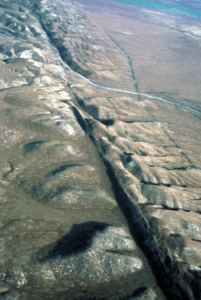

In his keynote at the National Earthquake Conference, Thomas Jordan, director of the Southern California Earthquake Center declared that, “The springs on the San Andreas system have been wound very, very tight. In particular, the southern San Andreas fault looks like it’s locked, loaded and ready to go.” The San Andreas Fault system, is the boundary between the Pacific and North America tectonic plates and stretches from Cape Mendocino in northern California to the Mexican border. The Pacific plate is slipping northwards along the North America plate, taking cities such as Los Angeles, San Diego, Santa Barbara, San Francisco and

Monterey along for the ride, while other California cities sit directly in the fault zone.
The San Andreas Fault zone is composed of many segments that can move independently of other segments. Historically, earthquakes have occurred along the southern zone of the San Andreas without accompanying movement along its northern segments. To complicate matters, the San Andreas also intersects with many other, smaller faults along its length. While seismologists have estimated that earthquakes should be relieving about 16 feet of accumulated movement every 100 years along the San Andreas, some segments of the fault zone have seen no significant earthquakes for over 100 years. The many smaller Southern California earthquakes have not adequately relieved the stress along this fault zone.
On a panel hosted by the California Earthquake Authority (CEA) at the National Earthquake Conference, Maiclaire Bolton, CoreLogic® senior product manager for global earthquake products, shared how scientists at CoreLogic have used the latest comprehensive Uniform California Earthquake Rupture Forecast version 3 (UCERF3) along with the 2014 United States Geological Survey (USGS) National Seismic Hazard Model to create catastrophe models that enable better understanding of the risk associated with earthquakes. Because the models take into account the probability of multi-segment ruptures along such faults as the San Andreas, there is an enhanced ability to evaluate the full extent of earthquake risk exposure when events trigger other events either on the same fault or a nearby fault.
A 2008 USGS report based on a simulation of a magnitude 7.8 earthquake on the southern San Andreas Fault warned that such an earthquake could cause more than 1,800 deaths, 50,000 injuries and $200 billion in damage along with severe, long-lasting disruptions.
So what can homeowners do to protect themselves and their property against the next “big one”? First, they should investigate their level of risk. The USGS has online earthquake risk maps for all of the United States; because while this article focuses on California, it is not the only state in which homeowners are subject to earthquake risk. Since typical homeowner’s policies don’t cover earthquake damage, an additional earthquake policy is a smart first move if the property is within a high-risk area. In the past, some homeowners assumed that earthquake coverage was too expensive. However, what many may not know is that rates for earthquake policies from the California Earthquake Authority (CEA) have come down and now include more deductible flexibility. Click here to access the USGS’s new premium calculator.
Also, homeowners should review their regular homeowner’s policy. Is it up to date and does it provide adequate coverage in case of loss? Fires from exploding gas lines and downed power lines as well as water damage from broken water lines are common events following major earthquakes
Retrofitting older homes to mitigate earthquake risk can potentially lower insurance premiums. To help with the cost of retrofitting, California has a Brace + Bolt program which offers financial incentives to certain homeowners in a limited number of higher-seismic-risk zip codes. Simple things like making sure the strapping on water heaters are secure, anchoring large bookcases, TVs, and pictures to the wall and knowing where and how to shut off gas and water valves can help homeowners protect their home and belongings.
Finally, everyone should know what to do during an earthquake – DROP! COVER! HOLD ON! Every at-risk family should have an earthquake plan that includes who to contact and where to meet if an earthquake hits. Many websites including the CEA, the Great ShakeOut earthquake preparedness movement, and most municipalities have information and checklists available on how homeowners can better prepare for the next “big one.”
© 2016 CoreLogic, Inc. All rights reserved.